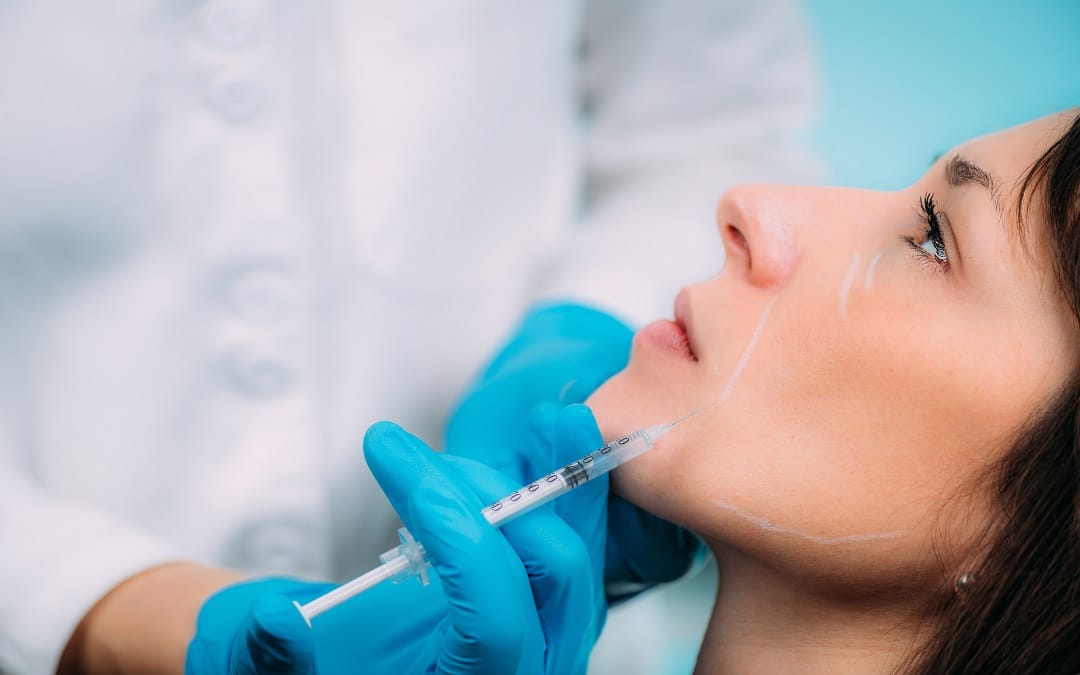If you aren’t sure if Botox or dermal fillers are right for you, you aren’t alone. Botox and dermal fillers now account for nine out of ten cosmetic procedures in the UK, and the demand for these cosmetic enhancements continues to grow in popularity as people seek the opportunity to refresh and rejuvenate their appearance.
While both Botox and dermal fillers have some similarities and are both administered through injections, each are used to treat different skin concerns and choosing which one is the best option for your needs can feel confusing.
Here, we look closer at the difference between botox and dermal fillers, what they are, what each is used for, and which one may be right for you.
What is Botox?
Botox, short for Botulinum Toxin, is a neurotoxic protein that works by blocking nerve signals in the muscles around the injection site, causing the muscle to become temporarily frozen. This helps reduce or event remove the appearance of fine lines and wrinkles.
What Areas do Botox Treat?
Botox is primarily used to diminish lines and wrinkles on the face caused by frequent muscle movement. The most common areas are around the upper face and mouth, where movement lines such as those that occur when we smile or frown. As we age, we also tend to see the appearance of resting lines in these areas, which appear even when we aren’t making an expression.
Botox is used to prevent, relax and in some cases, completely remove these lines.
Aside from lines and wrinkles, Botox also has a diverse range of uses, including the treatment of platysmal bands in the neck, teeth grinding, migraines and hyperhidrosis.
Pros and Cons
As with any cosmetic procedure, there are a few key pros and cons to consider when it comes to deciding if Botox is the right treatment for you.
Pros:
- Effective in reducing dynamic wrinkles
- Quick procedure with minimal downtime
Cons:
- Temporary results requiring repeat treatments
- Potential side effects like bruising and headaches
Cost Considerations
Botox treatments prices vary depending on the clinic you choose, the practitioner carrying out your treatment, the area being treated and the amount of units of Botox required.
Botox treatments usually last between 3–4 months, however some problem areas may take more than one treatment to see optimal results, so it’s important to budget accordingly.
At Boutique Dental 23, we offer a range of finance plans and payment options for your treatment. During your consultation, your practitioner will be able to give you a clear idea of the cost of your treatment and the options available to you.
What is Dermal Face Filler?
Dermal fillers, sometimes known as soft tissue fillers, are used to add volume and fullness to areas of the face by injecting filler substances beneath the surface of the skin. They are primarily used to help reduce the signs of ageing, the first signs of which often appear as the collagen and elasticity of our skin decreases.
What Areas do Dermal Filler Treat?
Dermal fillers are used to treat a number of areas on the face, but are most commonly used to treat concerns on the lower face.
One of the most common uses for dermal filler is to add volume to the lips, enhancing their natural shape, evening out texture and filling fine lines. Dermal fillers are also commonly used to plump out the cheek area and fill in forehead lines, unlike Botox which temporary freezes the muscles, minimising movement.
Dermal fillers are also often used as a non-surgical alternative to help reshape the chin or nose, reduce the appearance of scars and remove marionette lines and smile lines.
Pros and Cons
Pros:
- Immediate results with minimal downtime
- Longer-lasting effects compared to Botox
Cons:
- Possibility of temporary redness or swelling
- Some types of fillers may require allergy testing
Cost Considerations
Like Botox treatments, dermal fillers prices are highly dependent on the area of treatment and type of filler used. The costs associated with your treatment will be fully discussed during your consultation.
Treatments Key Differences
Botox treatments, derived from botulinum toxin, works by temporarily paralysing muscles, reducing the appearance of wrinkles and fine lines caused by muscle movement. It’s commonly used on dynamic wrinkles like crow’s feet and forehead lines.
On the other hand, dermal fillers, typically made of hyaluronic acid or other substances, add volume beneath the skin, filling in wrinkles, lines, and creases.
They’re effective for static wrinkles and areas that have lost volume, like cheeks and lips. While Botox inhibits muscle movement, dermal fillers replenish lost volume, providing a smoother and fuller appearance to the treated areas.
When to Choose Botox?
Botox is an ideal option for those whose primary concern is wrinkles caused by repeated muscle movements, such as crows feet or forehead lines.
It is also a great option for those looking for a preventative measure against the formation of future wrinkles caused by ageing, with many people choosing to begin preventative Botox treatments in their late 20s and early 30s.
When to Choose Dermal Fillers?
If you’re looking for a way to rejuvenate your skin by restoring lost volume and around your cheeks, lips or in lines and wrinkles around your face, then dermal fillers may be the best choice for you.
Dermal fillers excel at smoothing lines and creases that are permanent on the skin, such as smile lines. Dermal fillers are also an ideal choice for those seeking natural-looking enhancements. They provide subtle improvements by adding volume, resulting in a softer, rejuvenated appearance.
How Can Botox and Dermal Fillers Work Together?
When strategically used in combination, these treatments complement each other. Botox relaxes muscles to prevent further wrinkle formation, while fillers restore volume and smoothen existing lines, resulting in a more youthful and natural appearance.
Get in Touch Today
Take the first step towards a fresher, more rejuvenated you. Get in touch today and arrange for FREE facial rejuvenation treatments with an expert member of our team.
FAQs
1. Are dermal fillers better than Botulinum Toxin?
Dermal fillers and Botox serve different purposes in facial rejuvenation. It’s less about one being “better” than the other and more about your personal goals and concern areas. Sometimes, a combination of both treatments is best!
2. Which is more long-lasting, Botox or dermal fillers?
Typically, dermal fillers tend to lasts than Botox. While Botox effects can last around 3–4 months, dermal fillers can maintain results for 6 months to 2 years, depending on the type of filler used, the area treated, and individual metabolism.
3. Should you get Botox or fillers first?
There isn’t a strict rule on the order — it often depends on individual concerns. In some cases, addressing volume loss with fillers first can provide a foundational structure before using Botox to address dynamic wrinkles.
4. Do fillers look more natural than Botox?
When administered by a professional practitioner, both fillers and Botox injections can deliver natural-looking results. Fillers are often associated with more natural-looking volume enhancement, with Botox relaxed the muscles to reduce the appearance of wrinkles caused by facial expressions.
5. At what age should you stop getting Botox and fillers?
There’s no specific age to stop getting Botox injections or fillers. It varies based on individual preferences and skin conditions. Some individuals continue treatments well into their mature years, adjusting the frequency or type of treatment as needed.


